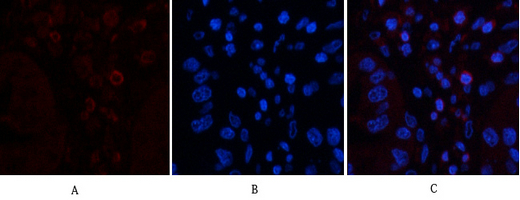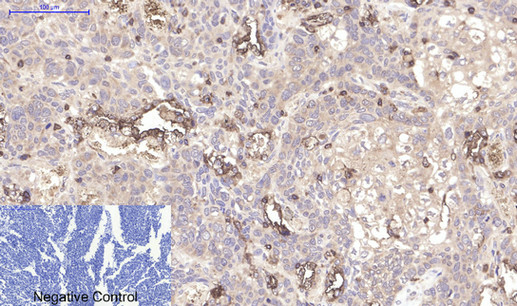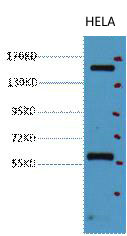产品名称
CD45(12A9)Mouse Monoclonal Antibody
别名
PTPRC; CD45; Receptor-type tyrosine-protein phosphatase C; Leukocyte common antigen; L-CA; T200; CD45
蛋白名称
Receptor-type tyrosine-protein phosphatase C
存储缓冲液
PBS, pH 7.4, containing 0.5%BSA, 0.02% New type preservative N as Preservative and 50% Glycerol.
Human Gene Link
http://www.ncbi.nlm.nih.gov/sites/entrez?db=gene&term=5788
Human Swissprot No.
P08575
Human Swissprot Link
http://www.uniprot.org/uniprotkb/P08575/entry
Mouse Swissprot No.
P06800
Mouse Swissprot Link
http://www.uniprot.org/uniprot/P06800
Rat Gene Link
http://www.ncbi.nlm.nih.gov/sites/entrez?db=gene&term=24699
Rat Swissprot Link
http://www.uniprot.org/uniprot/P04157
免疫原
Synthetic Peptide of CD45
特异性
The antibody detects endogenous CD45 proteins.
稀释度
IF 1:50-200 WB 1:2000 IHC 1:50-300
背景介绍
The protein encoded by this gene is a member of the protein tyrosine phosphatase (PTP) family. PTPs are known to be signaling molecules that regulate a variety of cellular processes including cell growth, differentiation, mitosis, and oncogenic transformation. This PTP contains an extracellular domain, a single transmembrane segment and two tandem intracytoplasmic catalytic domains, and thus is classified as a receptor type PTP. This PTP has been shown to be an essential regulator of T- and B-cell antigen receptor signaling. It functions through either direct interaction with components of the antigen receptor complexes, or by activating various Src family kinases required for the antigen receptor signaling. This PTP also suppresses JAK kinases, and thus functions as a regulator of cytokine receptor signaling. Alternatively spliced transcripts variants of this gene, which enc
组织表达
Isoform 1: Detected in thymocytes. Isoform 2: Detected in thymocytes. Isoform 3: Detected in thymocytes. Isoform 4: Not detected in thymocytes. Isoform 5: Detected in thymocytes. Isoform 6: Not detected in thymocytes. Isoform 7: Detected in thymocytes. Isoform 8: Not detected in thymocytes.
细胞定位
Cell membrane ; Single-pass type I membrane protein . Membrane raft . Colocalized with DPP4 in membrane rafts. .
信号通路
Cell adhesion molecules (CAMs);T_Cell_Receptor;Fc gamma R-mediated phagocytosis;Primary immunodeficiency;
功能
alternative products:At least 8 isoforms are produced,catalytic activity:Protein tyrosine phosphate + H(2)O = protein tyrosine + phosphate.,disease:Defects in PTPRC are a cause of severe combined immunodeficiency autosomal recessive T-cell-negative/B-cell-positive/NK-cell-positive (T(-)B(+)NK(+)SCID) [MIM:608971]. SCID refers to a genetically and clinically heterogeneous group of rare congenital disorders characterized by impairment of both humoral and cell-mediated immunity, leukopenia, and low or absent antibody levels. Patients with SCID present in infancy with recurrent, persistent infections by opportunistic organisms. The common characteristic of all types of SCID is absence of T-cell-mediated cellular immunity due to a defect in T-cell development.,disease:Genetic variations in PTPRC are involved in multiple sclerosis susceptibility (MS) [MIM:126200]. MS is a neurodegenerative disorder characterized by the gradual accumulation of focal plaques of demyelination particularly in the periventricular areas of the brain. Peripheral nerves are not affected. Onset usually in third or fourth decade with intermittent progression over an extended period. The cause is still uncertain.,domain:The first PTPase domain interacts with SKAP1.,function:Required for T-cell activation through the antigen receptor. The first PTPase domain has enzymatic activity, while the second one seems to affect the substrate specificity of the first one. Upon T-cell activation, recruits an dephosphorylates SKAP1 and FYN.,online information:CD45 entry,online information:PTPRC mutation db,PTM:Heavily N- and O-glycosylated.,similarity:Belongs to the protein-tyrosine phosphatase family. Receptor class 1/6 subfamily.,similarity:Contains 2 fibronectin type-III domains.,similarity:Contains 2 tyrosine-protein phosphatase domains.,subunit:Binds GANAB and PRKCSH (By similarity). Interacts with SKAP1.,
纯化
The antibody was affinity-purified from mouse ascites by affinity-chromatography using specific immunogen.



